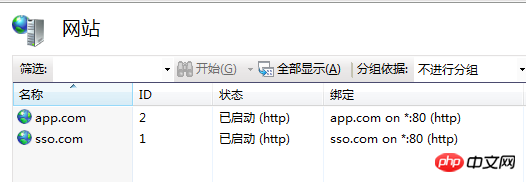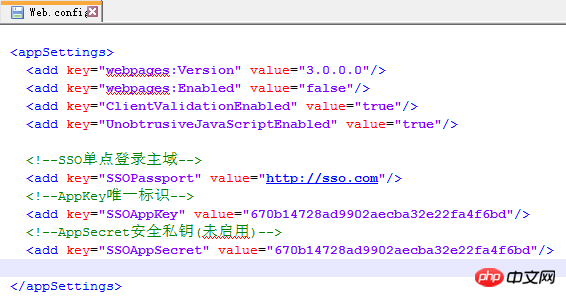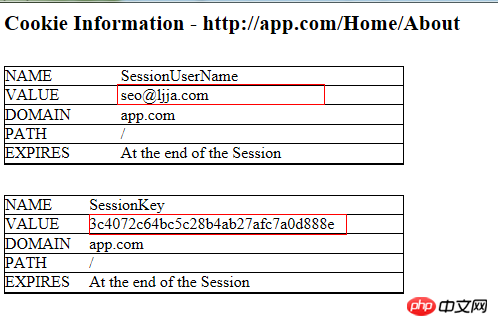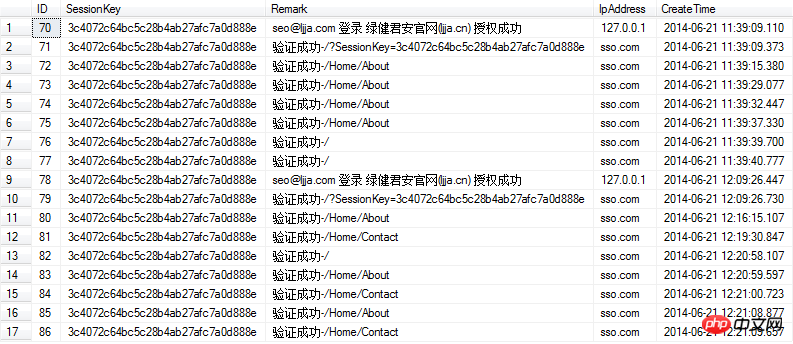详解ASP.NET MVC SSO单点登录设计实例
实验环境配置
HOST文件配置如下:
127.0.0.1 app.com
127.0.0.1 sso.com
IIS配置如下:

应用程序池采用.Net Framework 4.0

注意IIS绑定的域名,两个完全不同域的域名。
app.com网站配置如下:

sso.com网站配置如下:
memcached缓存:

数据库配置:

数据库采用EntityFramework 6.0.0,首次运行会自动创建相应的数据库和表结构。
授权验证过程演示:
在浏览器地址栏中访问:http://app.com,如果用户还未登陆则网站会自动重定向至:http://sso.com/passport,同时通过QueryString传参数的方式将对应的AppKey应用标识传递过来,运行截图如下:
URL地址:http://sso.com/passport?appkey=670b14728ad9902aecba32e22fa4f6bd&username=

输入正确的登陆账号和密码后,点击登陆按钮系统自动301重定向至应用会掉首页,毁掉成功后如下所示:

由于在不同的域下进行SSO授权登陆,所以采用QueryString方式返回授权标识。同域网站下可采用Cookie方式。由于301重定向请求是由浏览器发送的,所以在如果授权标识放入Handers中的话,浏览器重定向的时候会丢失。重定向成功后,程序自动将授权标识写入到Cookie中,点击其他页面地址时,URL地址栏中将不再会看到授权标示信息。Cookie设置如下:

登陆成功后的后续授权验证(访问其他需要授权访问的页面):
校验地址:http://sso.com/api/passport?sessionkey=xxxxxx&remark=xxxxxx
返回结果:true,false
客户端可以根据实际业务情况,选择提示用户授权已丢失,需要重新获得授权。默认自动重定向至SSO登陆页面,即:http://sso.com/passport?appkey=670b14728ad9902aecba32e22fa4f6bd&username=seo@ljja.cn 同时登陆页面邮箱地址文本框会自定补全用户的登陆账号,用户只需输入登陆密码即可,授权成功后会话有效期自动延长一年时间。
SSO数据库验证日志:
用户授权验证日志:

用户授权会话Session:

数据库用户账号和应用信息:

应用授权登陆验证页面核心代码:
/// <summary> /// 公钥:AppKey /// 私钥:AppSecret /// 会话:SessionKey /// </summary> public class PassportController : Controller { private readonly IAppInfoService _appInfoService = new AppInfoService(); private readonly IAppUserService _appUserService = new AppUserService(); private readonly IUserAuthSessionService _authSessionService = new UserAuthSessionService(); private readonly IUserAuthOperateService _userAuthOperateService = new UserAuthOperateService(); private const string AppInfo = "AppInfo"; private const string SessionKey = "SessionKey"; private const string SessionUserName = "SessionUserName"; //默认登录界面 public ActionResult Index(string appKey = "", string username = "") { TempData[AppInfo] = _appInfoService.Get(appKey); var viewModel = new PassportLoginRequest { AppKey = appKey, UserName = username }; return View(viewModel); } //授权登录 [HttpPost] public ActionResult Index(PassportLoginRequest model) { //获取应用信息 var appInfo = _appInfoService.Get(model.AppKey); if (appInfo == null) { //应用不存在 return View(model); } TempData[AppInfo] = appInfo; if (ModelState.IsValid == false) { //实体验证失败 return View(model); } //过滤字段无效字符 model.Trim(); //获取用户信息 var userInfo = _appUserService.Get(model.UserName); if (userInfo == null) { //用户不存在 return View(model); } if (userInfo.UserPwd != model.Password.ToMd5()) { //密码不正确 return View(model); } //获取当前未到期的Session var currentSession = _authSessionService.ExistsByValid(appInfo.AppKey, userInfo.UserName); if (currentSession == null) { //构建Session currentSession = new UserAuthSession { AppKey = appInfo.AppKey, CreateTime = DateTime.Now, InvalidTime = DateTime.Now.AddYears(1), IpAddress = Request.UserHostAddress, SessionKey = Guid.NewGuid().ToString().ToMd5(), UserName = userInfo.UserName }; //创建Session _authSessionService.Create(currentSession); } else { //延长有效期,默认一年 _authSessionService.ExtendValid(currentSession.SessionKey); } //记录用户授权日志 _userAuthOperateService.Create(new UserAuthOperate { CreateTime = DateTime.Now, IpAddress = Request.UserHostAddress, Remark = string.Format("{0} 登录 {1} 授权成功", currentSession.UserName, appInfo.Title), SessionKey = currentSession.SessionKey }); 104 var redirectUrl = string.Format("{0}?SessionKey={1}&SessionUserName={2}", appInfo.ReturnUrl, currentSession.SessionKey, userInfo.UserName); //跳转默认回调页面 return Redirect(redirectUrl); } }Memcached会话标识验证核心代码:public class PassportController : ApiController { private readonly IUserAuthSessionService _authSessionService = new UserAuthSessionService(); private readonly IUserAuthOperateService _userAuthOperateService = new UserAuthOperateService(); public bool Get(string sessionKey = "", string remark = "") { if (_authSessionService.GetCache(sessionKey)) { _userAuthOperateService.Create(new UserAuthOperate { CreateTime = DateTime.Now, IpAddress = Request.RequestUri.Host, Remark = string.Format("验证成功-{0}", remark), SessionKey = sessionKey }); return true; } _userAuthOperateService.Create(new UserAuthOperate { CreateTime = DateTime.Now, IpAddress = Request.RequestUri.Host, Remark = string.Format("验证失败-{0}", remark), SessionKey = sessionKey }); return false; } }Client授权验证Filters Attribute
public class SSOAuthAttribute : ActionFilterAttribute { public const string SessionKey = "SessionKey"; public const string SessionUserName = "SessionUserName"; public override void OnActionExecuting(ActionExecutingContext filterContext) { var cookieSessionkey = ""; var cookieSessionUserName = ""; //SessionKey by QueryString if (filterContext.HttpContext.Request.QueryString[SessionKey] != null) { cookieSessionkey = filterContext.HttpContext.Request.QueryString[SessionKey]; filterContext.HttpContext.Response.Cookies.Add(new HttpCookie(SessionKey, cookieSessionkey)); } //SessionUserName by QueryString if (filterContext.HttpContext.Request.QueryString[SessionUserName] != null) { cookieSessionUserName = filterContext.HttpContext.Request.QueryString[SessionUserName]; filterContext.HttpContext.Response.Cookies.Add(new HttpCookie(SessionUserName, cookieSessionUserName)); } //从Cookie读取SessionKey if (filterContext.HttpContext.Request.Cookies[SessionKey] != null) { cookieSessionkey = filterContext.HttpContext.Request.Cookies[SessionKey].Value; } //从Cookie读取SessionUserName if (filterContext.HttpContext.Request.Cookies[SessionUserName] != null) { cookieSessionUserName = filterContext.HttpContext.Request.Cookies[SessionUserName].Value; } if (string.IsNullOrEmpty(cookieSessionkey) || string.IsNullOrEmpty(cookieSessionUserName)) { //直接登录 filterContext.Result = SsoLoginResult(cookieSessionUserName); } else { //验证 if (CheckLogin(cookieSessionkey, filterContext.HttpContext.Request.RawUrl) == false) { //会话丢失,跳转到登录页面 filterContext.Result = SsoLoginResult(cookieSessionUserName); } } base.OnActionExecuting(filterContext); } public static bool CheckLogin(string sessionKey, string remark = "") { var httpClient = new HttpClient { BaseAddress = new Uri(ConfigurationManager.AppSettings["SSOPassport"]) }; var requestUri = string.Format("api/Passport?sessionKey={0}&remark={1}", sessionKey, remark); try { var resp = httpClient.GetAsync(requestUri).Result; resp.EnsureSuccessStatusCode(); return resp.Content.ReadAsAsync<bool>().Result; } catch (Exception ex) { throw ex; } } private static ActionResult SsoLoginResult(string username) { return new RedirectResult(string.Format("{0}/passport?appkey={1}&username={2}", ConfigurationManager.AppSettings["SSOPassport"], ConfigurationManager.AppSettings["SSOAppKey"], username)); } }示例SSO验证特性使用方法:
[SSOAuth] public class HomeController : Controller { public ActionResult Index() { return View(); } public ActionResult About() { ViewBag.Message = "Your application description page."; return View(); } public ActionResult Contact() { ViewBag.Message = "Your contact page."; return View(); } }总结:
从草稿示例代码中可以看到代码性能上还有很多优化的地方,还有SSO应用授权登陆页面的用户账号不存在、密码错误等一系列的提示信息等。在业务代码运行基本正确的后期,可以考虑往更多的安全性层面优化,比如启用AppSecret私钥签名验证,IP范围验证,固定会话请求攻击、SSO授权登陆界面的验证码、会话缓存自动重建、SSo服务器、缓存的水平扩展等。
更多相关文章
- Asp.NET页面事件加载的顺序是什么样的
- .net验证后台页面是否登录实例教程
- ASP.NET Core Razor页面路由的详细介绍
- ASP.NET Core中用户登录验证实现最低配置的示例代码
- 用户管理和权限和设置——mysql
- c语言用户标识符命名规则是什么?
- C语言中用户标识符是什么?
- C语言中用户标识符的命名规则是什么
- go语言使用revel框架实现用户注册教程(附代码)
